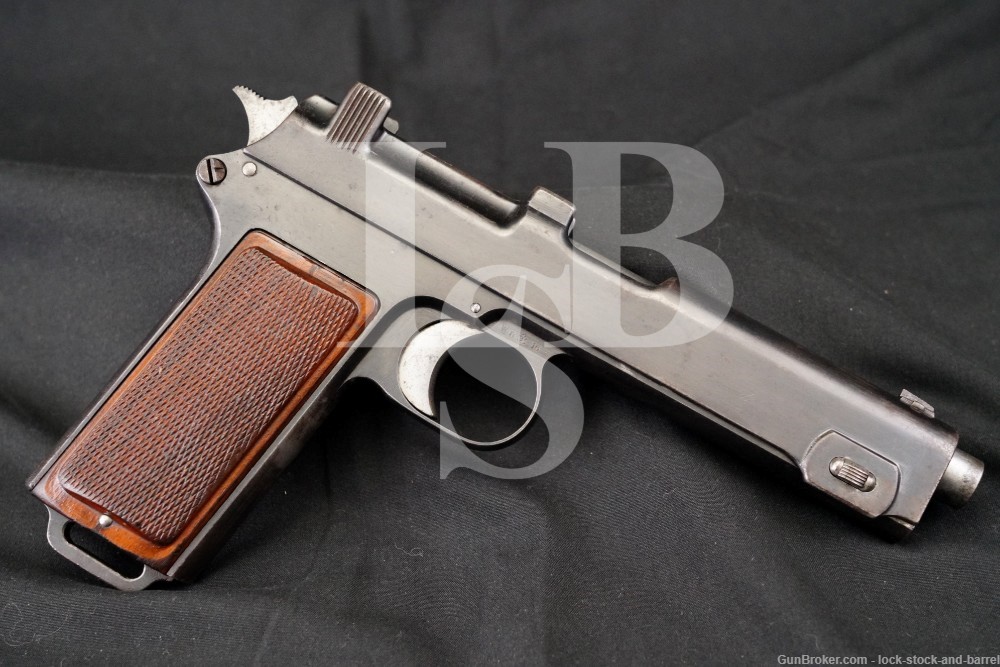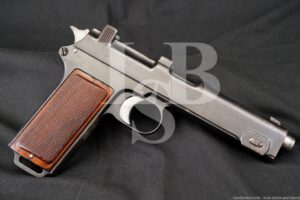
WWI Austrian Steyr-Hahn Model 1912 9x23mm Semi-Automatic Pistol Ca 1916 C&R
SOLD FOR: $3000
LSB#: 230114JD028
Make: Österreichische Waffenfabriks-Gesellschaft in Steyr
Model: Steyr-Hahn Model 1912
Serial#: 7801m
Year of Manufacture: 1916, C&R
Caliber: 9x23mm Steyr (not 9mm Luger)
Action Type: Single-Action Semi-Automatic Pistol with an Integral Magazine fed by Stripper Clips
Markings: The left side of the slide is marked with the serial number “7801m”, “STEYR 1916”, a small “K” ( for Kontroll, control in English, an inspection mark) and a large “S” (abbreviation for Scharfe Patrone which is German for live cartridge). The left side of the frame is marked with the serial number and a “K” inspection mark ahead of the safety lever. The safety lever itself is marked with a “K” inspection mark. The right side of the trigger guard is marked: “wn” on the left side of a Hapsburg Eagle and date code “16”. The left side of the lanyard loop is marked with a “K” inspection stamp and a faded mark. The follower, left side of the hammer, cartridge release, guide rod and top of the extractor are all marked with the “K” inspection marking. The barrel lug is marked “K” and with the serial number.
Barrel Length: 5”
Sights/ Optics: The front sight is a blade dovetailed into the front of the slide. The rear sight is a “V”-notch at the rear end of the slide.
Stock Configuration & Condition/ Grip: The grip panels are two-piece checkered wood with smooth borders. The grips have some light handling marks, nicks and scuffs. The checkering is mostly sharp. Overall, the grips are in Very Good condition.
Type of Finish: Blue
Finish Originality: Original
Bore Condition: The bore is gray with well defined rifling. There is scattered light-moderate erosion and minor pitting, most concentrated in the grooves. On a scale of 1-10, the bore rates in about 6 out of 10.
Many military and C&R eligible weapons have bores that will show erosion. This is not only due to age but to the fact that corrosive primers were commonly used in ammunition worldwide until the 1960s.
Overall Condition: The pistol retains about 75% of its metal finish. The finish is thinning at all edges. There is handling wear in the grip areas and on the slide’s serrations. There is some other scattered minor finish wear and scattered minor surface oxidation. There are some scattered light marks, most notable are nicks on the left of the slide and frame between the grip and slide serrations. The action shows operational wear. The screwheads range from sharp to tool marked with strong slots. The markings are clear. Overall, the pistol is in Very Good condition.
Mechanics: The action functions correctly. The single action trigger is crisp. The slide to frame fit is snug. We have not fired this pistol. As with all used firearms, a thorough cleaning may be necessary to meet your maintenance requirements.
Box Paperwork and Accessories: None.
Our Assessment: This is a Österreichische Waffenfabriks-Gesellschaft in Steyr manufactured Steyr-Hahn Model 1912 semi-automatic pistol made for service with the Austro Hungarian Army during WWI. The Austro-Hungarian role in WWI was significant, the war began as a result of Archduke Franz Ferdinand’s assassination in 1914. Gavrilo Princep, a Yugoslavian nationalist of Serbian origin, sought to liberate Sarajevo from Austria-Hungary and assassinated Habsburg Crown Prince Franz Ferdinand and his wife on June 28th, 1914. Princep was arrested by the Austro-Hungarian authorities who put him on trial where he plainly stated “I am a Yugoslav nationalist”, despite this the Austro Hungarians portrayed the event as an act of Serbian state sponsored terrorism. Serbia was presented with a harsh ultimatum by Austria-Hungary on July 23 and only given 48 hours to reply. Diplomatic wrangling played out for the next five days before Austria-Hunagry declared war on Serbia. Austria-Hungary’s ally Germany exacerbated the crisis by preemptively declaring war on Russia, France and Belgium. Britain responded by declaring war on Germany. Austria-Hungary and the Ottoman Empire followed Germany’s lead soon thereafter; it is generally assumed that Germany and Austria-Hungary were looking for a pretext to start the conflict.
The Austro-Hungarian Army’s war effort was mainly focused on fighting against Italy which switched sides in 1915 (it originally sided with Germany and Austria before joining the Entente Powers), the war against Russia and several conflicts in Eastern Europe including the poorly executed invasion of Serbia. The Austro-Hungarian forces were poorly led and faced repeated failures in the field, often having to rely on German support to reverse their losses. The war ended in a catastrophic defeat for Austria-Hungary, with the Hapsburg dynasty collapsing in the aftermath of the conflict. The war was very costly for the Austro-Hungarians who lost well over a million men during the conflict. This sidearm was manufactured for use in this brutal and unforgiving conflict.
The Steyr-Hahn Model 1912 was a popular sidearm in the Austro-Hungarian Army, it was durable and well-suited to extreme conditions. This particular handgun was made in 1916, two years into WWI, as Austro-Hungarian troops fought across several theaters. The pistol has some light wear, but it retains a strong action and remains both ergonomic and mechanically sound. The markings remain crisp and the gun has a unique aesthetic. This is a great option for fans of historical firearms and WWI history aficionados. Good luck on your bid!
Please forgive any typos, I was educated in California. -Bud

